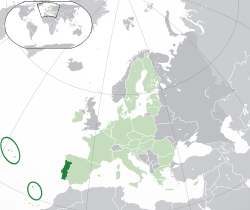Portuguese Third Republic
|
Portuguese Republic
República Portuguesa (Portuguese)
|
|
|---|---|

Location of Portugal (dark green)
– in Europe (green & dark grey) |
|
| Capital and largest city |
Lisbon 38°46′N 9°9′W / 38.767°N 9.150°W |
| Official languages | Portuguese |
| Recognised regional languages | Mirandese |
| Ethnic groups (2011) |
|
| Demonym | Portuguese |
| Government | Unitary semi-presidential constitutional republic |
| Marcelo Rebelo de Sousa | |
| Eduardo Ferro Rodrigues | |
| António Costa | |
| Legislature | Assembly of the Republic |
| Formation | |
| 868 | |
| 1095 | |
| 24 June 1128 | |
|
• Kingdom
|
26 July 1139 |
| 5 October 1143 | |
| 23 May 1179 | |
| 1 December 1640 | |
|
• Republic
|
5 October 1910 |
| 25 April 1974 | |
| 25 April 1976 | |
| 1 January 1986 | |
| Area | |
|
• Total
|
92,212 km2 (35,603 sq mi) (111th) |
|
• Water (%)
|
0.5 |
| Population | |
|
• 2015 estimate
|
10,341,330 (83rd) |
|
• 2011 census
|
10,562,178 |
|
• Density
|
115/km2 (297.8/sq mi) (97th) |
| GDP (PPP) | 2017 estimate |
|
• Total
|
$306.762 billion (50th) |
|
• Per capita
|
$29,422 (40th) |
| GDP (nominal) | 2017 estimate |
|
• Total
|
$213.001 billion (43th) |
|
• Per capita
|
$20,429 (36th) |
| Gini (2013) |
medium |
| HDI (2015) |
very high · 41st |
| Currency | Euro (€) (EUR) |
| Time zone |
WET/GMT (UTC) AZOT (UTC−1) |
|
• Summer (DST)
|
WEST (UTC+1) AZOST (UTC) |
| Note: Mainland Portugal and Madeira use WET/WEST, the Azores use AZOT/AZOST | |
| Antipodes |
New Zealand and Pacific Ocean |
| Date format | dd/mm/yyyy |
| Drives on the | right |
| Calling code | +351 |
| ISO 3166 code | PT |
| Internet TLD | .pt |
|
|
– in Europe (green & dark grey)
– in the European Union (green)
The Third Portuguese Republic is a period in the history of Portugal corresponding to the current democratic regime installed after the Carnation Revolution of 25 April 1974, that put an end to the paternal autocratic regime of Estado Novo of António de Oliveira Salazar and Marcello Caetano. It was initially characterized by constant instability and was threatened by the possibility of a civil war during the early post-revolutionary years. A new constitution was drafted, censorship was prohibited, free speech declared, political prisoners were released and major Estado Novo institutions were closed. Eventually the country granted independence to its African colonies and begun a process of democratization that led to the accession of Portugal to the EEC (today's European Union) in 1986.
In Portugal, 1926 marked the end of the First Republic, in a military coup that established an authoritarian government called Estado Novo, that was led by António de Oliveira Salazar until 1968, when he was forced to step down due to health problems. Salazar was succeeded by Marcelo Caetano. The government faced many internal and external problems, including the Portuguese Colonial War.
...
Wikipedia


